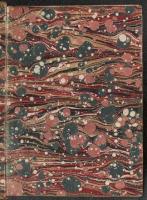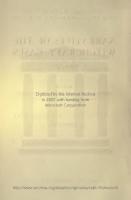Basic Technologies of Witchcraft
394 14 37KB
English Pages 10
Recommend Papers

- Similar Topics
- Literature
File loading please wait...
Citation preview
BASIC TECHNOLOGIES OF WITCHCRAFT
BASIC TECHNOLOGIES OF WITCHCRAFT Author: Unknown
Get any book for free on: www.Abika.com
Get any book for free on: www.Abika.com
1
BASIC TECHNOLOGIES OF WITCHCRAFT
This is the outline for a collection of four semi-formal training sessions for people interested in starting out in "The Craft" or Neopaganism. It is intended to give enough grounding to effectively participate in ritual, with the expectation that those that are really dedicated, skilled, and/or interested will undertake further study. Since this is for beginners, there are no textbooks, no required reading, and the course only deals with such material as can be taught in four 1-1/2 to 2 hour informal sessions. I. DAY ONE: Neopagan Traditions The first day's material is a basic overview of Neopagan history and tradition, intended to make people more comfortable with the subject. A. History of The Craft Examine two topics to show how they influence the modern witch: how Neopagan witchcraft grew out of and borrows from the Gardnerian Reformation, and how our Craft Law developed from a variety of traditions and needs. 1. Origins, Ancient (?) and Modern Fact before theory: discuss the evolution of witchcraft from Gardner onwards, then overview the evidences that witchcraft is a pre-Christian and (possibly) pre-historic religion. a. The Gardnerian Reformation Discussion of Gerald Gardner and both the original and modern versions of Gardnerian Witchcraft (with a quick side-line into its off-shoot and competitor, Alexandrian Witchcraft). b. The Church of All Worlds and Neopaganism History of the Church of All Worlds and its contributions, including the word "neopagan" and "Green Egg", the journal in which the framework of modern, Neopagan witchcraft was developed from the framework of Gardnerianism crossed with Greco/Roman and Egyptian pagan traditions.
Get any book for free on: www.Abika.com
2
BASIC TECHNOLOGIES OF WITCHCRAFT
c. The Non-Pagan Branches of the Craft Other types of witches: Feminist Wicca, Church of Wicca, the Masonic Druids of England, and the Family Traditionalists. d. Evidences of Stone-Age Witchcraft Discuss some of the evidence that witchcraft carries on a tradition with stone-age origins and a 10,000 year history, both pro and con. Emphasize that there is no conclusive evidence one way or the other. 2. Craft Law, Ancient and Modern a. The Reasons for Craft Law Discuss how the in-bred fear of of the Powers of Evil, combined with the need to trust each other against the Inquisition, gave birth to the concept of Craft Law. b. The Wiccan Rede "An it harm none, do what thou will." Stress both the libertine and the disciplinarian interpretations of that law. Discuss the Law of Karma, and how the Wiccan Rede (interpreted properly) becomes more of a safety rule than a Commandment. c. The Rule of Secrecy Gloss quickly over the Inquisition (everybody knows enough), and examine some of the evidence that a "witchhunt" is being begun. Encourage the students to recognize that the decision to be public or secretive has to be made by each individual, and they have the right to expect others to respect their privacy on this matter. 3. Magick in Theory and Practice Magick is the unifying force in all of the Neopagan Traditions. To lay the groundwork for Day Two, explain the basic theories of magick, and how they influence the design and practice of Neopagan ritual.
Get any book for free on: www.Abika.com
3
BASIC TECHNOLOGIES OF WITCHCRAFT
a. The Basic Rules of Magick Explain that the central theory of magick is that reality can be altered by a sufficiently strong will, focused by the proper ritual. For comparison and contrast, mention Bell's Hypothesis, from quantum physics. Discuss seriously the possibility that all that the magician alters is his own mind and awareness of how the world works. b. Magick and Neopagan Ritual Define the two classic types of ritual: religious and magickal, or (better terms) theurgical and thaumaturgical. Show how magick is used in both, and where the rituals diverge. B. The Magick Circle Even more than the pentacle, the Magick Circle is the central symbol of Neopagan Witchcraft. The final topic for Day One is the purpose, symbolism, and protocols of a pagan Circle. 1. Purpose and Symbolism a. Ceremonial Magic and Qabbalism versus the Pagan Circle Most people get their idea of what a circle is for from the Ceremonial magicians and kaballists, who use it for protection from outside magick. Emphasize that the quantum leap that Gardner made was to think of using the circle INSTEAD to keep beneficial magick WITHIN the ritual area until it is fully built-up, focused, and directed. b. The Power of the Circle: The Five Elements Discuss how the classic Four Elements of Greek science are the symbols for four types of power, four states of matter, four types of personality, and so forth, showing correspondences. Highlight the difference between elemental power, psychic power, and divine power - and the similarities. Explain how the elements are used in casting the circle. c. Ritual Tools
Get any book for free on: www.Abika.com
4
BASIC TECHNOLOGIES OF WITCHCRAFT
Discuss one-by-one the tools that a witch uses to focus her mind - the athame, the elemental symbols (salt or a pentacle for earth, a candle or lamp for fire, the incense and the wand for air, the chalice for water), the magic mirror, the sword, candles, herbs, and the use of images. 2. Conduct within the Circle Two final bits of information needed inside the circle: the directions of casting and the integrity of the circle. a. Widdershins and Deosil Define the terms (deosil = clockwise, widdershins = counter-clockwise). Explain that widdershins is often mistaken for evil, but show that the difference is more accurately raising or bannishing power. Stress that, in order to get along, when in doubt, go deosil. b. The Integrity of the Circle Remind people that, since no evil magick is involved, there is no RISK involved in leaving a circle. However, stress that since a circle is supposed to CONTAIN energy it should not be punctured hastily or unnecessarily. Teach how to open and close gateways in the circle, and when to and not to do so. II. DAY TWO: MEDITATION AND VISUALIZATION The second day's concentration is on the mental aspects of magick and ritual work, and is mostly in workshop form. A. Meditation Describe meditation as a means of altering your mental state by relaxation and concentration. Contrast meditation and trance state. Discuss the use of posture (asana) and paradoxical breathing (pranayama) to attain a meditative state, then do a few quick exercises. B. Visualization(s) Explain the difference between imagining and visualizing, then
Get any book for free on: www.Abika.com
5
BASIC TECHNOLOGIES OF WITCHCRAFT
stress the similarities. Stress the fact that visualization is something that you will continually get better at - but there is still no "wrong way." Then lead the students through the following exercises: 1. Grounding and Centering Using the seven chakras as steps along the way, guide them to visualize energy being drawn up from the Earth and blown through the tops of their heads (at the crown chakra) in a free-flowing fountain. Then (if they seem up to it), guide them to mold and direct that energy flow into a circle, then a sphere of blinding white light. Have them draw the circle back down through their spines until it is returned to the Earth. 2. Contacting Your Magickal Self Get them as relaxed as possible and in a deep meditative state, then starting with a visualization of a Safe Place in the forest, lead them to a fairy hill, then through the Maze of the subconscious until they are somewhat lost. Guide them to a long stairway, then through the door at the top. Then set the mental setting - that at the doorway they change into a powerful magician, and suddenly all of the tools and symbols in the room are meaningful. Instruct them to study the tools for a while. After a minute or two, lead them back out through the maze, then to the clearing, and wake them back up. 3. Aura Reading and Healing a. Diagnosis Guide them to ground and center (as II.B.1, above), then stand in front of an evenly-lit white wall. Have them open their eyes and stare at a point in the distance beyond the instructor. (Note: this will for some of them be the first time that they'll be channeling power with their eyes open, so take your time.) Instruct them to look for the greyish line around me (that is actually an optical illusion). Once they've found it, instruct them to visualize it being replaced with a wash of color. Have them examine it for variations in thickness or color.
Get any book for free on: www.Abika.com
6
BASIC TECHNOLOGIES OF WITCHCRAFT
b. Treatment Point out an ill or sore region on the instructor's body. Have them examine it for variations in color or brilliance. Pick one student, then have him wrap his hands in the energy that he's drawing, then "tune" it to the color of the healthy areas in the aura. Instruct him to use his hands as if he were rubbing on oil or paint to color over the sick area, visualizing the new color (healthy energy) replacing the older area, and continue until the color stays changed after he's no longer touching it or until he gets tired. III.DAY THREE: BASIC RITUAL TECHNIQUES The previous two courses teach the full minimum necessary to work solo magick. The remaining two days will concentrate on group ritual. In Day Three, we will discuss the basic techniques. To explain the outline, relate the outline of the three Essentials of Eastern magick - mandalla, mantra, and mudra. A. Mantra - Music and Chanting Discuss the three types of mantra most often used in Neopagan ritual: memorized chants (for creating and focusing the Group Mind), impromptu chanting (for advanced meditation and growing together), and plainsong (for worship). 1. Memorized Chants Teach them the chants listed below. Then run quickly (for familiarization purposes only) through "We Wander Now", "Hoof and Horn", "Burn Bright", "Circle 'Round the Fire", and any others that I can remember on the spot. a. "We All Come from the Goddess" We ALL - COME from the GODdess AND to HER we SHALL reTURN LIKE a DROP - OF - RAIN FLOWing TO the O-CEAN (repeat) b. "I Circle Around" I CIRcle aROUND, I CIRcle aROUND ...
Get any book for free on: www.Abika.com
7
BASIC TECHNOLOGIES OF WITCHCRAFT
the BOUN-'DRIES OF the EARTH ... WEARing my LONG tail FEAthers AS I GLIDE ... WEARing my LONG tail FEAthers AS I GLIDE ... (repeat) c. "Air I Am" (evenly spaced, every syllable emphasized) Air I am, Fire I am, Water, Earth and Spirit I am ... (repeat) d. "The Goddess Chant" iSIS, aSTARte, diANna, HECaTE, deMEter, KALi - inNAna (repeat) 2. Impromptu Chanting Discuss the uses of impromptu chanting: ecstatic magick (where one can't count on elaborate chants) and for deep probing rituals, where they are used for free association. As an example, demonstrate the three-word style that Starhawk teaches in SPIRAL DANCE. Emphasize the use of beat and tempo as unifying factors. 3. Plainsong For contrast, sing the NROOGD classic, "O Earth Mother" to demonstrate that not all ritual music needs to be in the form of basic chants. B. Mudra - Movement and Dance 1. Ritual Dance (This section has not yet been finalized. Current plans focus on simple circle-dance steps, the famed "spiral dance", and then brief discussion of free-form dance and ecstatic ritual.) 2. Theater Techniques Remind people that one of the purposes of ritual is to catch and hold the attention of Child Self, and point out that the language that Child Self speaks best is melodrama. Instruct
Get any book for free on: www.Abika.com
8
BASIC TECHNOLOGIES OF WITCHCRAFT
them that gestures and actions in the Circle should speak loud enough that words are not necessary. Then, since they undoubtedly won't get the point, do two exercises to rub their noses in it. a. Banishing Exercise Set up a circle, then pick out someone who seems to know a bit about magick. Get him to go to one of the quarters and ground and center. Then have him visualize a threat approaching from his quarter, and tell him to do a banishing. (He will inevitably do something traditional, elaborate, and sterile.) Relax him, then ask the class how THEY would have reacted, if THEY were attacking the circle, to what he had done. Pick an absolute novice, put him in the same place, ground and center, pump them up with melodrama and heroics, then describe a different menace and instruct them to scare it off, turn it away (don't use the word "banish"). See if the gestures aren't more dramatic. b. Charging Exercise Pick a couple who seem to know a bit about magick (if possible), and have them ground, center, and use the wand and chalice for a symbolic Great Rite. (See if they do anything more sexual than just stick the wand into the cup - I doubt it.) Relax them, then point out to the class that the energies to be raised in this exercise are to be earthy and sexual, EXACTLY like the "rush" or thrill of heavy flirtation. Then pick the most COMPATIBLE-looking couple (if possible) and repeat the exercise (and see if they don't make it more energetic). IV. NEOPAGAN SYMBOLISM Today's lecture has two purposes. First, we will deal with the legends, meta-legends, and conventions that form the basis for most Neopagan ritual. Then we will discuss the purposes behind a witchcraft initiation, and walk through the one that the graduates of this class will perform. A. Theology/Thealogy Theology and thealogy (the alpha-ending, Thea, being the Greek
Get any book for free on: www.Abika.com
9
BASIC TECHNOLOGIES OF WITCHCRAFT
feminine ending) are outlined to show how Neopagans relate to their own and other people's choices of gods. The hook on which this will all be hung is that most of the Gods represent facets of human experience personified. 1. Forms of the God Discuss the various types of masculine gods that appear in pagan and Neopagan myth: the Sun-child, the Horned Hunter, the Sensitive Artist, and the Lord of Death. 2. Forms of the Goddess Discuss the image of the Three-Fold Goddess: the Maiden, the Mother, and the Crone. B. The Wheel of the Year Read aloud the story of the Wheel of the Year from THE SPIRAL DANCE, pages 28 and 29. Point out that this is the solar calendar, and relate it to the agricultural cycle. Then add the mystical component by telling the story of Persephone's descent into the underworld, showing how it relates to the Wheel. C. Initiation Tell the story of how Osiris was slain by his jealous brother, Set, and how his sister/wife Isis went down into the Underworld to gain the secret of resurrection from the dead (for reminders, use Wilson's account in COSMIC TRIGGER). Discuss how Isis's humiliation in the land of the dead compares to the psychology of initiation (with a brief aside into Paul's revelation of Eleusis: "Except a seed of grain fall into the Earth and die, it cannot rise again"). Use this and the discussion from Day One of how Craft Law arose to outline the dual purpose of a witchcraft initiation: to lead the initiate through humiliation and death into elevation and new life, and to bind the initiate to the laws necessary for the group experience of the Craft. Finally, if time permits, do a walk-through of the initiation to familiarize the candidates with it, then give them their scripts to memorize.
Get any book for free on: www.Abika.com
10





![Witchcraft Today - Book Three: Witchcraft & Shamanism [3]
1567181503](https://ebin.pub/img/200x200/witchcraft-today-book-three-witchcraft-amp-shamanism-3-1567181503.jpg)


